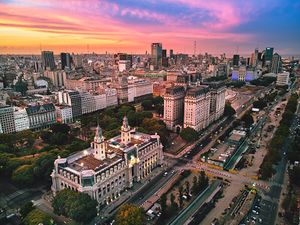Buenos Aires
(City) | |
|---|---|
 | |
| Political, cultural and economic capital of Argentina. |
Buenos Aires is the capital and largest city of Argentina.
The Greater Buenos Aires conurbation, which also includes several Buenos Aires Province districts, constitutes the fourth-most populous metropolitan area in the Americas, with a population of around 15.6 million.[1]
19th and 20th century
During most of the 19th century, the political status of the city remained a sensitive subject. It was already the capital of Buenos Aires Province, and between 1853 and 1860 it was the capital of the seceded State of Buenos Aires. The issue was fought out more than once on the battlefield, until the matter was finally settled in 1880 when the city was federalized and became the seat of government, with its mayor appointed by the president. The Casa Rosada became the seat of the president.
Health conditions in poor areas were appalling, with high rates of tuberculosis. Contemporaneous public health physicians and politicians typically blamed both the poor themselves and their ramshackle tenement houses (conventillos) for the spread of the dreaded disease. People ignored public-health campaigns to limit the spread of contagious diseases, such as the prohibition of spitting on the streets, the strict guidelines to care for infants and young children, and quarantines that separated families from ill loved ones.
In addition to the wealth generated by customs duties and Argentine foreign trade in general, as well as the existence of fertile pampas, railroad development in the second half of the 19th century increased the economic power of Buenos Aires as raw materials flowed into its factories. A leading destination for immigrants from Europe, particularly Italy and Spain, from 1880 to 1930, Buenos Aires became a multicultural city that ranked itself alongside the major European capitals.
Buenos Aires also attracted migrants from Argentina's provinces and neighboring countries. Shanty towns (villas miseria) started growing around the city's industrial areas during the 1930s, leading to pervasive social problems and social contrasts with the largely upwardly-mobile Buenos Aires population. These laborers became the political base of Peronism, which emerged in Buenos Aires during the pivotal demonstration of 17 October 1945, at the Plaza de Mayo. Industrial workers of the Greater Buenos Aires industrial belt have been Peronism's main support base ever since, and Plaza de Mayo became the site for demonstrations and many of the country's political events; on 16 June 1955, however, a splinter faction of the Navy bombed the Plaza de Mayo area, killing 364 civilians (see Bombing of Plaza de Mayo). This was the only time the city was attacked from the air, and the event was followed by a military uprising which deposed President Perón, three months later.
In the 1970s the city suffered from the fighting between left-wing revolutionary movements (Montoneros, ERP and F.A.R.) and the right-wing paramilitary group Triple A, supported by Isabel Perón, who became president of Argentina in 1974 after Juan Perón's death.
The March 1976 coup, led by General Jorge Videla, only escalated this conflict; the "Dirty War" resulted in 30,000 desaparecidos (people kidnapped and killed by the military during the years of the junta). The silent marches of their mothers (Mothers of the Plaza de Mayo) are a well-known image of Argentines' suffering during those times.
On 17 March 1992, a bomb exploded in the Israeli Embassy, killing 29 and injuring 242. Another explosion, on 18 July 1994, destroyed a building housing several Jewish organizations, killing 85 and injuring many more.
Economy
Buenos Aires is the financial, industrial, and commercial hub of Argentina. The economy in the city proper alone, measured by Gross Geographic Product (adjusted for purchasing power), totaled US$84.7 billion (US$34,200 per capita) in 2011[2] and amounts to nearly a quarter of Argentina's as a whole.[3] Metro Buenos Aires, according to one well-quoted study, constitutes the 13th largest economy among the world's cities.[4] The Buenos Aires Human Development Index (0.867 in 2018) is likewise high by international standards.[5]
The port of Buenos Aires is one of the busiest in South America, as navigable rivers by way of the Rio de la Plata connect the port to northeastern Argentina, Brazil, Uruguay and Paraguay. As a result, it serves as the distribution hub for said vast area of the South American continent. The Port of Buenos Aires handles over 11,000,000 metric tons (11,000,000 long tons; 12,000,000 short tons) annually,[6] and Dock Sud, just south of the city proper, handles another 17,000,000 metric tons (17,000,000 long tons; 19,000,000 short tons) .[7] Tax collection related to the port has caused many political problems in the past, including a conflict in 2008 that led to protests and a strike in the agricultural sector after the government raised export tariffs.[8]
Event
| Event | Description |
|---|---|
| 1994 Buenos Aires bombing | Suicide van bomb attack on the Argentine Israelite Mutual Association building in Buenos Aires, killing 85 people and injuring hundreds. For political reasons tried pinned on Hezbollah |
Group
| Group | Start | Description |
|---|---|---|
| University of Buenos Aires | 1821 | One of the most prestigious universities of the Spanish-speaking world |
References
- ↑ https://web.archive.org/web/20101220143832/http://www.censo2010.indec.gov.ar/preliminares/cuadro_totalpais.asp
- ↑ https://web.archive.org/web/20090325001525/http://estatico.buenosaires.gov.ar/areas/hacienda/sis_estadistico/anuario_2006/tomo1/09.pdf
- ↑ https://web.archive.org/web/20080313001135/http://www.mecon.gov.ar/secpro/dir_cn/documentos/producto_bruto_geografico.xls
- ↑ https://web.archive.org/web/20120918030640/http://www.citymayors.com/statistics/richest-cities-2005.html
- ↑ https://web.archive.org/web/20071009140109/http://www.desarrollohumano.org.ar/IDHArgentina/98_nac/98_nac.html
- ↑ https://web.archive.org/web/20110706083833/http://www.puertobuenosaires.gov.ar/estadisticas/11-2010w.pdf
- ↑ https://web.archive.org/web/20120420011546/http://www.worldportsource.com/ports/ARG_Port_of_Dock_Sud_187.php |
- ↑ https://web.archive.org/web/20080803120812/http://www.latimes.com/news/nationworld/world/la-fg-farmers19-2008jul19%2C0%2C2489386.story